

Avoiding Dependencies. I gave a one day class to about 20 developers today introducing Microsoft .NET, C#, and ASP.NET.
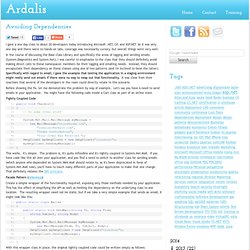
As it was only one day and there were no hands-on labs, coverage was necessarily cursory, but overall things went very well. In the course of discussing the Base Class Library and specifically the areas of logging and sending emails (System.Diagnostics and System.Net), I was careful to emphasize to the class that they should definitely avoid making direct calls to these namespaces' members for their logging and emailing needs. Instead, they should encapsulate their dependency on these classes using one of two patterns (and I'm inclined to favor the latter).
Specifically with regard to email, I gave the example that testing the application in a staging environment might really send out emails if there were no way to swap out that functionality. It was clear from their reactions that several of the developers in the room could directly relate to this scenario. Unity 2.0 – April 2010. Patterns & practices Developer Center April 2010 Unity is a lightweight, extensible dependency injection container with support for instance and type interception.
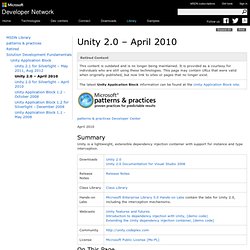
Overview What’s New Getting Started Community Feedback and Support Authors and Contributors Related Titles Unity is a lightweight, extensible dependency injection container. It facilitates building loosely coupled applications and provides developers with the following advantages: Simplified object creation, especially for hierarchical object structures and dependencies Abstraction of requirements; this allows developers to specify dependencies at run time or in configuration and simplify management of crosscutting concerns Increased flexibility by deferring component configuration to the container Service location capability, which allows clients to store or cache the container Instance and type interception.
Unity Container. Se Habla Code. The Unit Of Work Pattern And Persistence Ignorance. Patterns in Practice The Unit Of Work Pattern And Persistence Ignorance Jeremy Miller In the April 2009 issue of MSDN Magazine ("Persistence Patterns") I presented some common patterns that you will encounter when using some sort of Object/Relational Mapping (O/RM) technology to persist business entity objects.

I think it's unlikely that you or your team will be writing your own O/RM tooling from scratch, but these patterns are important to know to effectively use (or even just to choose) existing tooling. In this article, I would like to continue the discussion of persistence patterns with the Unit of Work design pattern and examine the issues around persistence ignorance. The Unit of Work Pattern One of the most common design patterns in enterprise software development is the Unit of Work.
Www.objectmentor.com/resources/articles/WorkingEffectivelyWithLegacyCode.pdf. Wiki. Ninject is a lightweight dependency injection framework for .NET applications.
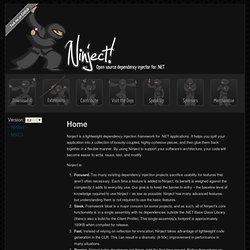
It helps you split your application into a collection of loosely-coupled, highly-cohesive pieces, and then glue them back together in a flexible manner. By using Ninject to support your software’s architecture, your code will become easier to write, reuse, test, and modify. Ninject is: Inversion of Control Containers and the Dependency Injection pattern. In the Java community there's been a rush of lightweight containers that help to assemble components from different projects into a cohesive application.

Underlying these containers is a common pattern to how they perform the wiring, a concept they refer under the very generic name of "Inversion of Control". In this article I dig into how this pattern works, under the more specific name of "Dependency Injection", and contrast it with the Service Locator alternative. Castle Project – build your .NET projects on a rock solid foundation. List of .NET Dependency Injection Containers (IOC) Inversión de control e inyección de dependencias « Gerardo Contijoch. La inversión de control (IoC -Inversion of control-, de ahora en adelante) es un principio en el cual se basan muchos de los patrones que vemos día a día.
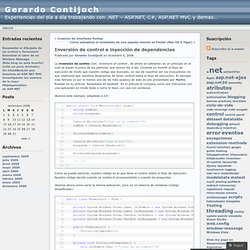
Consiste en invertir el flujo de ejecución de modo que nuestro código sea invocado, en vez de nosotros ser los invocadores (lo que implicaría que nosotros dejaríamos de tener control sobre el flujo de ejecución). El ejemplo más famoso (o por lo menos uno de los más usados) de esto es uno presentado por Martin Fowler en su artículo ‘Inversion of control‘. En el artículo él compara como uno interactúa con una aplicación en modo texto y como lo hace con una con ventanas. Veamos este ejemplo, adaptado a C#: 1: public static void Main(string[] args){ 2: string nombre; 3: string busqueda;
The Onion Architecture : part 1 : Jeffrey Palermo (.com) This is part 1. part 2. part 3. part 4.
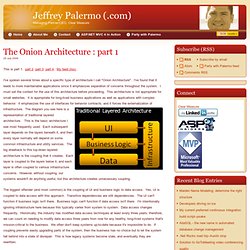
My feed (rss). I've spoken several times about a specific type of architecture I call "Onion Architecture". I've found that it leads to more maintainable applications since it emphasizes separation of concerns throughout the system. I must set the context for the use of this architecture before proceeding. This architecture is not appropriate for small websites. The diagram you see here is a representation of traditional layered architecture. The biggest offender (and most common) is the coupling of UI and business logic to data access. I propose a new approach to architecture. The diagram to the left depicts the Onion Architecture. In the very center we see the Domain Model, which represents the state and behavior combination that models truth for the organization. The Onion Architecture relies heavily on the Dependency Inversion principle. The database is not the center.